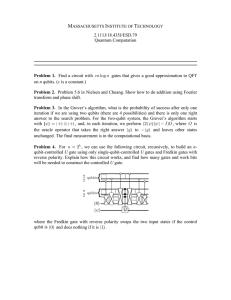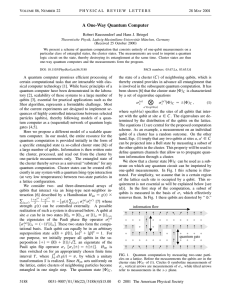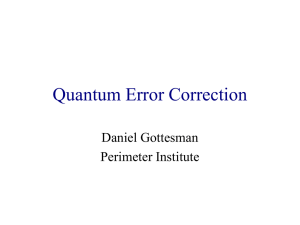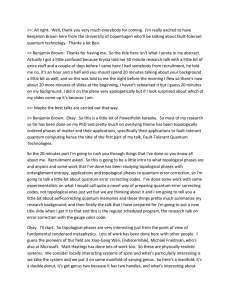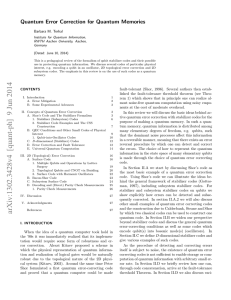M I T
advertisement
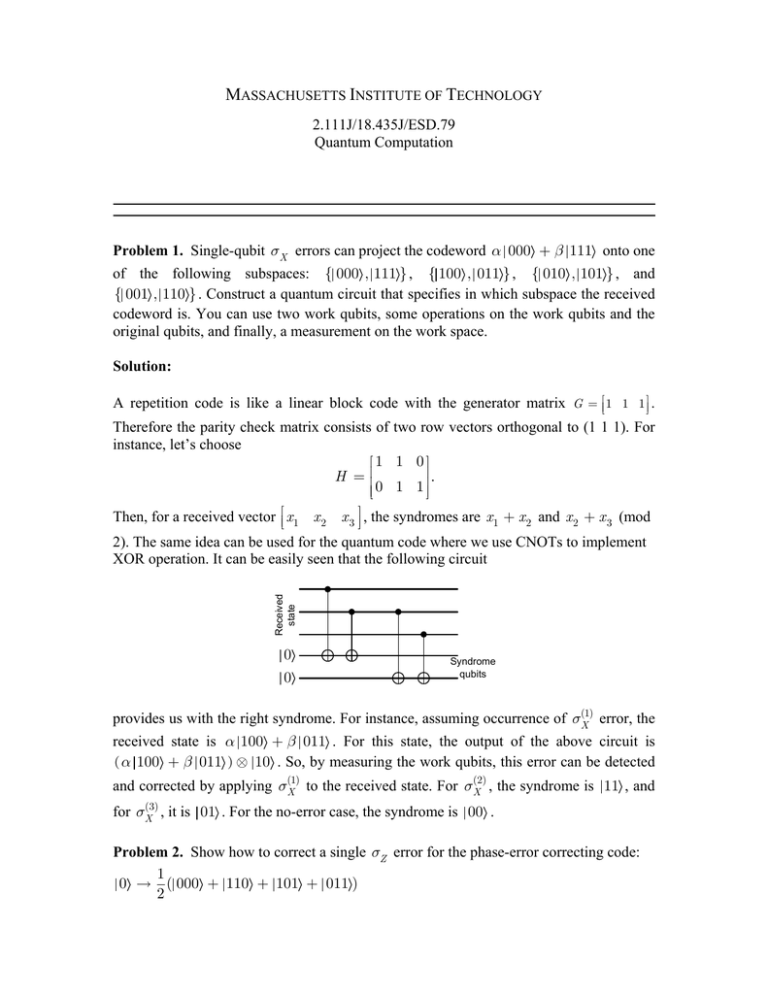
MASSACHUSETTS INSTITUTE OF TECHNOLOGY
2.111J/18.435J/ESD.79
Quantum Computation
Problem 1. Single-qubit σX errors can project the codeword α 000 + β 111 onto one
of the following subspaces: { 000 , 111 } , { 100 , 011 } , { 010 , 101 } , and
{ 001 , 110 } . Construct a quantum circuit that specifies in which subspace the received
codeword is. You can use two work qubits, some operations on the work qubits and the
original qubits, and finally, a measurement on the work space.
Solution:
Received
state
A repetition code is like a linear block code with the generator matrix G = 1 1 1 .
Therefore the parity check matrix consists of two row vectors orthogonal to (1 1 1). For
instance, let’s choose
1 1 0
.
H =
0
1
1
Then, for a received vector x1 x 2 x 3 , the syndromes are x1 + x 2 and x 2 + x 3 (mod
2). The same idea can be used for the quantum code where we use CNOTs to implement
XOR operation. It can be easily seen that the following circuit
0
0
Syndrome
qubits
provides us with the right syndrome. For instance, assuming occurrence of σX(1) error, the
received state is α 100 + β 011 . For this state, the output of the above circuit is
( α 100 + β 011 ) ⊗ 10 . So, by measuring the work qubits, this error can be detected
and corrected by applying σX(1) to the received state. For σX(2) , the syndrome is 11 , and
for σX(3) , it is 01 . For the no-error case, the syndrome is 00 .
Problem 2. Show how to correct a single σZ error for the phase-error correcting code:
1
0 → ( 000 + 110 + 101 + 011 )
2
1 →
1
( 111 + 001 + 010 + 100 ) .
2
Solution:
H
H
Error
Correction
Received
state
Remembering that 0 → ( + + + + − − − )/ 2 and 1 → ( + + + − − − − )/ 2
we just need to use Hadamard gates to take the received state from ± -space to 0 /1 space, use the circuit in Problem 1 to detect and correct the error, and use Hadamard
gates again to get the corrected received state back.
H
0
H
H
H
Syndrome qubits
Measurement
0
Problem 3. For the Shor’s nine-qubit code:
1
( 000 000 000 + 000 111 111
2
+ 111 000 111 + 111 111 000 )
1
1 → ( 000 000 111 + 000 111 000
2
+ 111 000 000 + 111 111 111 ) ,
0 →
give a quantum circuit that corrects a possible single-qubit Pauli error.
Solution:
It’s a cascade of bit-flip error correction and phase-flip error correction:
Bit flip
Correcti
on
Received
state
0
0
0
0
H
Meas
H
H
Phase flip
Correction
H
H
H
Meas
H
Phase flip
Correction
H
H
0
Meas
Bit flip
Correcti
on
H
0
Meas
Bit flip
Correcti
on
0
0
H
H
H
H
Phase flip
Correction
H
H
H
H
Problem 4. For the quantum Hamming code, show that the vector − = ( 0 − 1 )/ 2
gets encoded to
1
x ,
ψ− = ∑ x − ∑
4 x ∈{H }
x ∈{G }−{H }
where {H } is the corresponding binary subspace spanned by
1 1 1 1 0 0 0
H = 1 1 0 0 1 1 0
1 0 1 0 1 0 1
and {G } − {H } is the set of complements of {H } , which is all elements of {H } +[1 1 1
1 1 1 1]. Then, show that
H ⊗7 ψ− =
1
x .
8 x ∈{G∑
}−{H }
Solution:
For the quantum Hamming code, we have
0 → ψ0 =
1 → ψ1 =
1
∑ x
8 x ∈{
H}
1
x
8 x ∈{G∑
}−{H }
Therefore,
− → ( ψ0 − ψ1 )/ 2 .
Now,
H ⊗7 ψ− =
=
=
1
x ⋅y
x ⋅y
(
1)
(
1)
y
y
−
−
−
∑
∑
∑
∑
210 x ∈{H} y
x ∈{G }−{H } y
1
x ⋅y
x ⋅y +w (y )
,
(
1)
(
1)
y
y
−
−
−
∑
∑
∑
∑
210 x ∈{H } y
x ∈{H } y
w(y ) ≡ Hamming Weight (y )
1
w (y )
,
{
}
(1
(
1)
)
H
y
−
−
∑
210
y ∈{G } using Ex. 10.25 for C = {H } ⇒ {H }⊥ = {G }
{H }
0
1
(1
(
1)
)
(1
(
1)
)
y
y
=
−
−
+
−
−
∑
∑
210 y ∈{H }
y ∈{G }−{H }
=
1
y ,
8 y ∈{G∑
}−{H }
where we used the fact that all codewords in {H} have even weights and all codewords in
{G}-{H} have odd weights.

